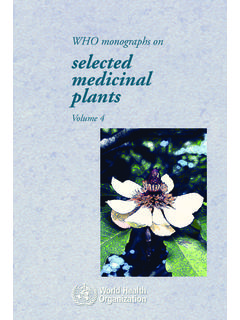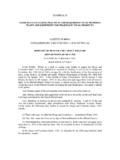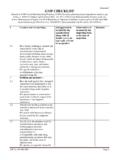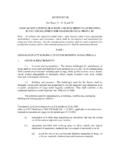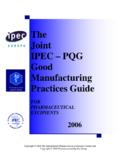Transcription of Annex 9 - World Health Organization
1 Annex 9 Guide to good storage practices for pharmaceuticals1 1. Introduction 1 2. Glossary 2 3. Personnel 3 4. Premises and facilities 4 5. Storage requirements 5 6. Returned goods 7 7. Dispatch and transport 7 8. Product recall 8 References 8 Bibliography 8 Appendix 10 Storage and labelling conditions 1. Introduction This guide is intended for those involved in the storage, transportation and distribution of pharmaceuticals.
2 It is closely linked to other existing guides recommended by the WHO Expert Committee on Specifications for Pharmaceutical Preparations, such as: good trade and distribution practice (GTDP) of pharmaceutical starting materials (1); The stability testing of pharmaceutical products containing well-established drug substances in conventional dosage forms (information given in connection with regulation for marketing authorization) (2); good manufacturing practices (GMP) (3); The cold chain, especially for vaccines and biologicals; The International Pharmacopoeia (4). The objective of this guide is to supplement the above-mentioned documents by describing the special measures considered appropriate for the storage and transportation of pharmaceuticals. However, they may be adapted to meet individual needs where necessary, provided that the desired standards of quality are still achieved.
3 The guidelines are applicable not only to manufacturers of medicinal products but also to pharmaceutical importers, contractors and wholesalers, and community and hospital pharmacies. They should be adjusted in line with the type of activity where the storage of pharmaceuticals is taking place. National or regional regulations should be followed 1 This guidance has been prepared in close collaboration with the International Pharmaceutical Federation (FIP). for all related activities. 2. Glossary The definitions given below of some of the terms used in this document take into account the terminology of current regulations and recommendations. active pharmaceutical ingredient (API) Any substance or mixture of substances intended to be used in the manufacture of a pharmaceutical dosage form and that, when used in the production of a drug, becomes an active ingredient of that drug.
4 Such substances are intended to furnish pharmacological activity or other direct effect in the diagnosis, cure, mitigation, treatment or prevention of disease, or to affect the structure and function of the body. contamination The undesired introduction of impurities of a chemical or microbiological nature, or of foreign matter, into or onto a starting material, or intermediate or finished product during production, sampling, packaging or repackaging, storage or transport. cross-contamination Contamination of a starting material, intermediate product or finished product with another starting material or product during production. excipient A substance, other than the active ingredient, which has been appropriately evaluated for safety and is included in a drug delivery system to: aid in the processing of the drug delivery system during its manufacture; protect, support or enhance stability, bioavailability, or patient acceptability; assist in product identification; or enhance any other attribute of the overall safety and effectiveness of the drug during storage or use.
5 Expiry date The date given on the individual container (usually on the label) of a drug product up to and including which the product is expected to remain within specifications, if stored correctly. It is established for each batch by adding the shelf-life to the date of manufacture. labelling The action involving the selection of the correct label, with the required information, followed by line clearance and application of the label. manufacture All operations of purchase of materials and products, production, quality control, release, storage and distribution of finished products, and the related controls. 2 material A general term used to denote starting materials (active pharmaceutical ingredients and excipients), reagents, solvents, process aids, intermediates, packaging materials and labelling materials. packaging material Any material, including printed material, employed in the packaging of a pharmaceutical product, but excluding any outer packaging used for transportation or shipment.
6 Packaging materials are referred to as primary or secondary according to whether or not they are intended to be in direct contact with the product. pharmaceutical product Any medicine intended for human use or veterinary product administered to food-producing animals, presented in its finished dosage form or as a starting material for use in such a dosage form, that is subject to control by pharmaceutical legislation in both the exporting state and the importing state. production All operations involved in the preparation of a pharmaceutical product, from receipt of materials, through processing, packaging and repackaging, labelling and relabelling, to completion of the finished product. retest date The date when a material should be re-examined to ensure that it is still suitable for use. storage The storing of pharmaceutical products and materials up to their point of use.
7 Supplier A person providing pharmaceutical products and materials on request. Suppliers may be agents, brokers, distributors, manufacturers or traders. Where possible, suppliers should be authorized by a competent authority. 3. Personnel At each storage site ( that of a manufacturer, distributor, wholesaler, community or hospital pharmacy) there should be an adequate number of qualified personnel to achieve pharmaceutical quality assurance objectives. National regulations on qualifications should be followed. All personnel should receive proper training in relation to good storage practice, regulations, procedures and safety. All members of staff should be trained in, and observe high levels of, personal hygiene and sanitation. Personnel employed in storage areas should wear suitable protective or working garments appropriate for the activities they perform. 34. Premises and facilities Storage areas Precautions must be taken to prevent unauthorized persons from entering storage areas.
8 Storage areas should be of sufficient capacity to allow the orderly storage of the various categories of materials and products, namely starting and packaging materials, intermediates, bulk and finished products, products in quarantine, and released, rejected, returned or recalled products. Storage areas should be designed or adapted to ensure good storage conditions. In particular, they should be clean and dry and maintained within acceptable temperature limits. Where special storage conditions are required on the label ( temperature, relative humidity), these should be provided, checked, monitored and recorded. Materials and pharmaceutical products should be stored off the floor and suitably spaced to permit cleaning and inspection. Pallets should be kept in a good state of cleanliness and repair. Storage areas should be clean, and free from accumulated waste and vermin. A written sanitation programme should be available indicating the frequency of cleaning and the methods to be used to clean the premises and storage areas.
9 There should also be a written programme for pest control. The pest-control agents used should be safe, and there should be no risk of contamination of the materials and pharmaceutical products. There should be appropriate procedures for the clean up of any spillage to ensure complete removal of any risk of contamination. Receiving and dispatch bays should protect materials and products from the weather. Reception areas should be designed and equipped to allow containers of incoming materials and pharmaceutical products to be cleaned, if necessary, before storage. Where quarantine status is ensured by storage in separate areas, these areas must be clearly marked and their access restricted to authorized personnel. Any system replacing physical quarantine should provide equivalent security. For example, computerized systems can be used, provided that they are validated to demonstrate security of access.
10 There should normally be a separate sampling area for starting materials in a controlled environment. If sampling is performed in the storage area, it should be conducted in such a way as to prevent contamination or cross-contamination. Adequate cleaning procedures should be in place for the sampling areas. Physical or other equivalent validated ( electronic) segregation should be provided for the storage of rejected, expired, recalled or returned materials or products. The materials or products, and areas concerned should be appropriately identified. Highly active and radioactive materials, narcotics and other hazardous, sensitive and/or dangerous materials and pharmaceutical products, as well as substances presenting special risks of abuse, fire or explosion, ( combustible liquids and solids and pressurized gases) should be stored in a dedicated area that is subject to appropriate additional safety and security measures.









